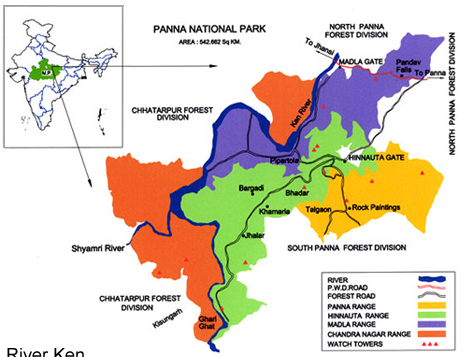|
Panna is the twenty second Tiger Reserve of India and
fifth in Madhya Pradesh . The Reserve is situated in the
Vindhyan Ranges and spreads over Panna and Chattarpur districts
in the north of the state.
Panna National Park was created in 1981. It was declared
a Project Tiger Reserve by Government of India in 1994.
The National Park consists of areas from the former Gangau
Wildlife Sanctuary created in 1975. This sanctuary comprised
of territorial forests of the present North and South Panna
Forest Division to which a portion of the adjoining Chhatarpur
forest division was added later. The reserved forests of
the Park in Panna district and some protected forests on
Chhatarpur side were the hunting preserves of the erstwhile
rulers of Panna, Chhatarpur and Bijawar princely states
in the past.
The location of the National Park is also important because
it is situated at a point where the continuity of the forest
belt, which starts from Cape Comorin in the south, is broken
and beyond this the great Gangetic plains begin. This area
is also the northern most tip of the natural teak forests
and the eastern most tip of the natural Kardhai ( Anogeissus
pendula ) forests.
The Ken river , which flows through the Reserve from south
to north, is home for Gharial and Mugger, and other aquatic
fauna and is one of the least polluted rivers and a tributary
of Yamuna. It is one of the sixteen perennial rivers of
Madhya Pradesh and is truly the life line of the Reserve.
Ken offers some of the most spectacular scenery to the visitor
while it meanders for some 55 km through the reserve.
The terrain of the reserve is characterised by extensive
plateaus and gorges. The reserve which has a bench topography,
can broadly be divided into three distinct tablelands on
Panna side: the upper Talgaon Plateau, the middle Hinnauta
plateau and the Ken valley. Series of undulating hills and
plateaus rise on the other side of Ken river in Chattarpur
district.
|





